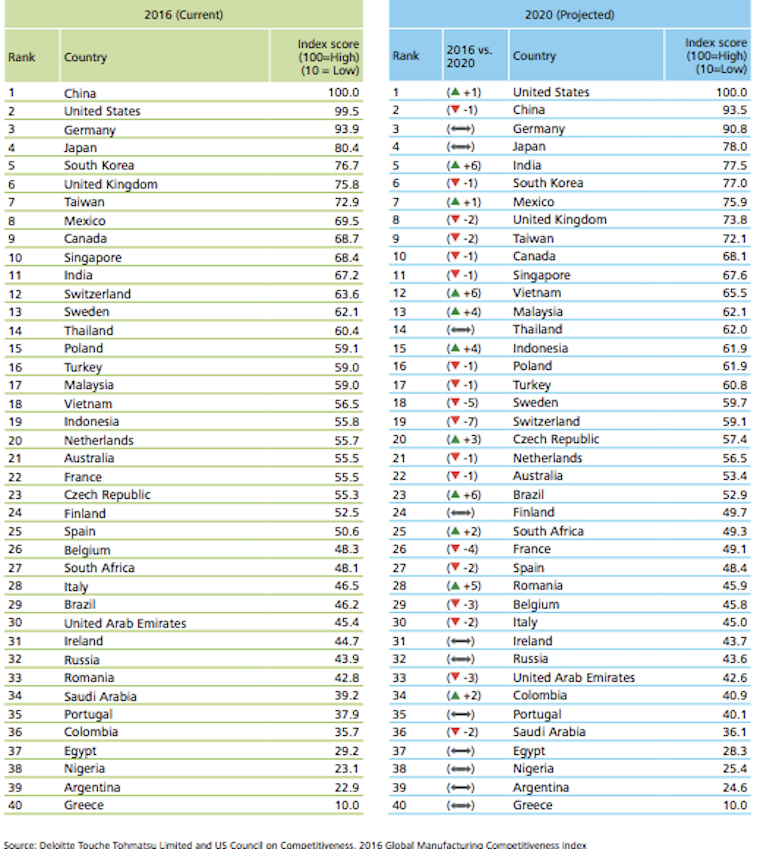See if you can pass this two-question quiz.
-
- The total number of U.S. manufacturing jobs decreased during the past three decades.
( ) True ( ) False - The total amount of U.S. manufacturing output decreased during the page three decades.
( ) True ( ) False
- The total number of U.S. manufacturing jobs decreased during the past three decades.
(Answers: 1. True 2. False)
Go ahead and sneak a peek at the correct answers. Despite a fall in the total number of U.S. manufacturing jobs over the past three decades, U.S. manufacturing output has grown by 80%, according to the U.S. Bureau of Labor Statistics.

Don’t feel bad if you missed #2. Most people miss it.
A recent survey of the Pew Research Center’s nationally representative American Trends Panel revealed that most Americans are unaware that while U.S. manufacturing jobs have contracted, manufacturing output has grown.
81% | Percentage of Americans who know the total number of manufacturing jobs in the U.S. has decreased over the past three decades
35% | Percentage of Americans who know the nation’s manufacturing output has risen over the same time span
26% | Percentage of Americans who know both
Productivity is what enables a company – or an entire economy – to produce more with fewer workers.
As a share of the overall workforce, manufacturing has been dropping steadily ever since the Korean War ended, as other sectors of the U.S. economy have expanded much faster.
32.1% | In 1954, the percentage of U.S. employment that was manufacturing-related
8.5% | Today, the percentage of U.S. employment that is manufacturing-related
What had been a slow decline in manufacturing-related employment accelerated after the turn of the 21st century, and especially during the Great Recession. And even though more than 900,000 manufacturing jobs have been added since, overall employment in manufacturing is still at its lowest level since before the U.S. entered World War II.
The competitive strength of U.S. manufacturing
$5.4 trillion | The value of goods and products made by U.S. manufacturers last year (in constant 2009 dollars), according to the Bureau of Economic Analysis.
On-going research by Deloitte of manufacturing executives around the world ranks the U.S. as the second most competitive nation for manufacturing in the world and predicts it will be #1 in 2020.
2016 Global Manufacturing Competitiveness Index rankings by country

Another fact about U.S. manufacturing that far too few people realize: The vast majority of manufacturing firms in the United States are quite small.
According to the National Association of Manufacturers, there were 251,901 firms in the manufacturing sector in 2014. All but 3,749 of those firms are considered to be small (i.e., having fewer than 500 employees).In fact, three-quarters of these firms have fewer than 20 employees. Despite that, state and local governments often pile on generous tax incentives to attract large manufacturers to their region.
Irony alert: Over the next decade, nearly 3½ million manufacturing jobs will likely be needed, and 2 million are expected to go unfilled due to the skills gap.
According to a recent report, 80 percent of manufacturers report a moderate or serious shortage of qualified applicants for skilled and highly-skilled production positions.
Bottomline
Because they pay well, manufacturing jobs have historically provided a great means for people to move into the middle class. However, in the way that the U.S. has become the world’s breadbasket while the percentage of U.S. worker in agriculture has plummeted, manufacturing will continue to be a dominant economic powerhouse while fewer and fewer workers will find entry-level jobs in the field. At the same time, there will be millions of manufacturing jobs that will go unfilled due to the lack of training.
VIA | Pew Research Center, Deloitte Touche Tohmatsu Limited, National Association of Manufacturers
